Why you should measure profitability and the simplest way to do so
Working in an agency is stressful. Tight deadlines, low budgets, constantly changing priorities, little to no time for quality work, and multiple fires burning at the same time. However, it doesn’t have to be this way if you track the profitability of your projects.
As an agency, you can increase stability and room to breathe by tracking and improving the profitability of your projects. No matter if you’re billing by the hour or on a retainer.
Not knowing the profitability of your projects is like driving a car without a fuel gauge. The adrenaline rush might be exciting short term but daunting long term.
And while there are many ways to measure profitability, here is the most simple way to do it.
Start by tracking time spent on activities for a project
No matter if you work on a retainer fee or hourly rate – time spent on a project is the biggest cost you have to compare the income with. Counting the hours is the obvious thing to do but that shouldn’t be the only thing. To dive deeper into the costs we recommend to track as well the different activities for a project. You’ll see later exactly why.
Unfortunately, no one likes to track time. Everyone just fills in their timesheets at the end of the week or month which we all know is inaccurate and hence useless to measure profitability. Might be good enough for invoicing you think? Unfortunately, it’s not, as three things are causing you to bill inaccurately and look at your profitability the wrong way.
- First, the average worker finishes 2-3 different tasks in the first hour of their workday but on the timesheets, they write down 4-5 per day. 1-2 more tasks within the rest of the day are very unlikely.
- Second, can you recall 90% of what you got done yesterday from the top of your head? What about Monday three weeks ago? It’s hard, right?
- Third, our perception of time is distorted by our emotions. An interesting hour at school feels like 10 minutes while a boring one feels like an eternity. Same at work. So when recalling what we did a while ago and how long it took, we very likely get it wrong.
Because of these three things, chances are high that you are undercharging and looking at inaccurate data to measure profitability. The solution?
Track time as early as possible, ideally immediately.
And how do you get your team to track all the things immediately?
In short: Keep it simple.
Employees want your company to succeed and be more profitable because that brings the stability and freedom to improve their work lives too. They just dislike spending a lot of time per day on something that doesn’t move the needle. If you are tracking time with Excel sheets or table-like interfaces it’s not simple enough. Effort and impact are not in balance. By keeping it simple it becomes lower effort and employees will do it right away.
So what is the most simple way to track it?
The most simple way to track time spent on project activities
Welcome Timeular. Timeular is super simple agency timesheet software because it combines the most simple ways to track time immediately into one solution.
You either just hit one shortcut on your computer, flip our 8-sided dice, or drag & drop time entries on a calendar interface.
If you don’t believe it’s simple then look at our reviews.
To get started, we recommend creating a space for every project and within that every activity you want to track. If your projects have similar names, add a client prefix to the space title so it’s easier to find. Or if you don’t have real projects but just clients, then just use that as a space title.
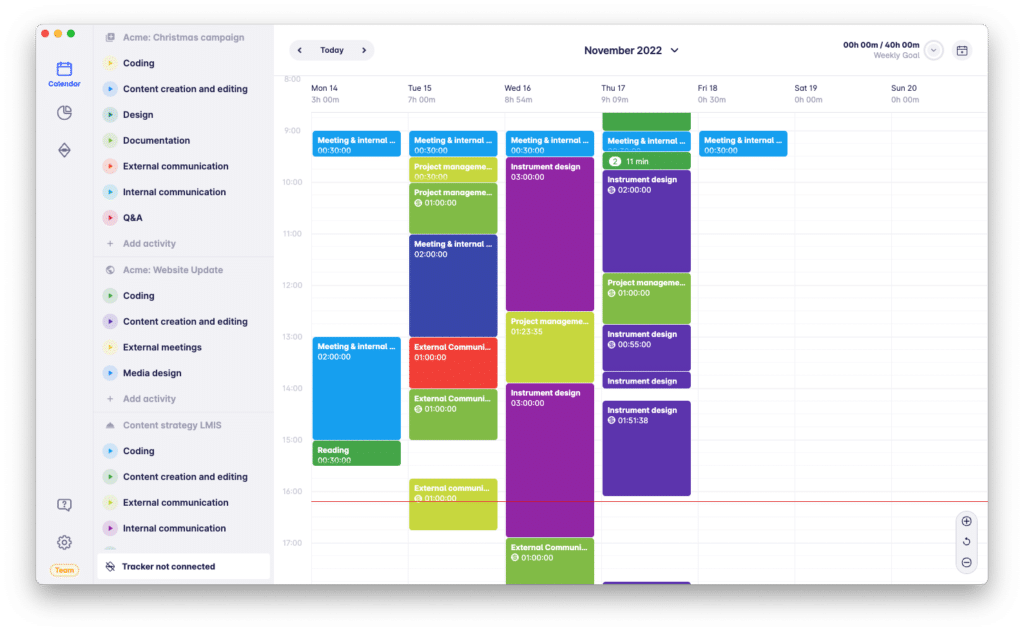
If it matters to you to track non-billable time separately, it’s easier to have an activity non-billable. Just track everything on that activity and optionally add a note to describe what has been done.
Alternatively, you could tag each time entry with #billable, #non-billable. But in our experience, people forget about adding those tags and it creates more work for something that shouldn’t happen too often. Again, keep it simple. Especially at the beginning.
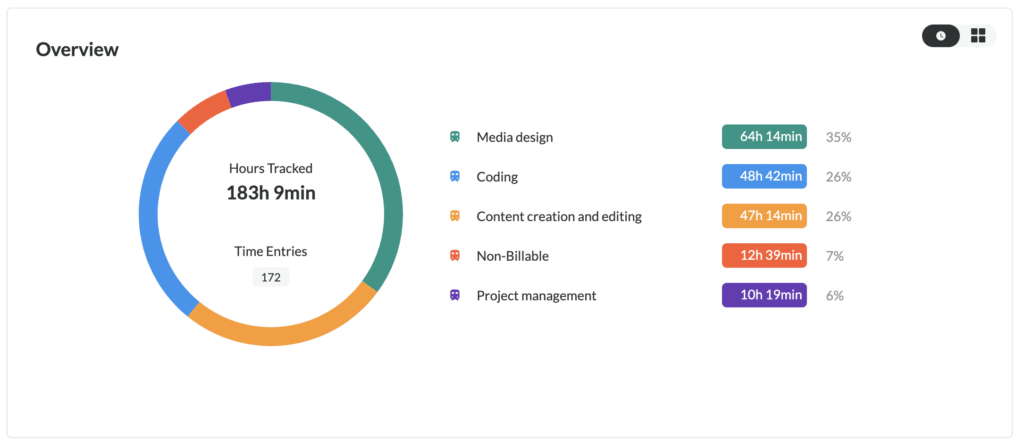
With this simple setup, you’ll get the accurate data needed to look at profitability in many different ways.
Find things to improve
After a couple of weeks, you can already start looking at the data and analyze your profitability. The most simple way is to just look at the time spent on each project, multiply it by your average hourly rate, and find differences between what you bill. Based on that put your projects into three buckets: Profitable, break-even, and unprofitable.
An example
Let’s look at an example of a small marketing agency with five projects.
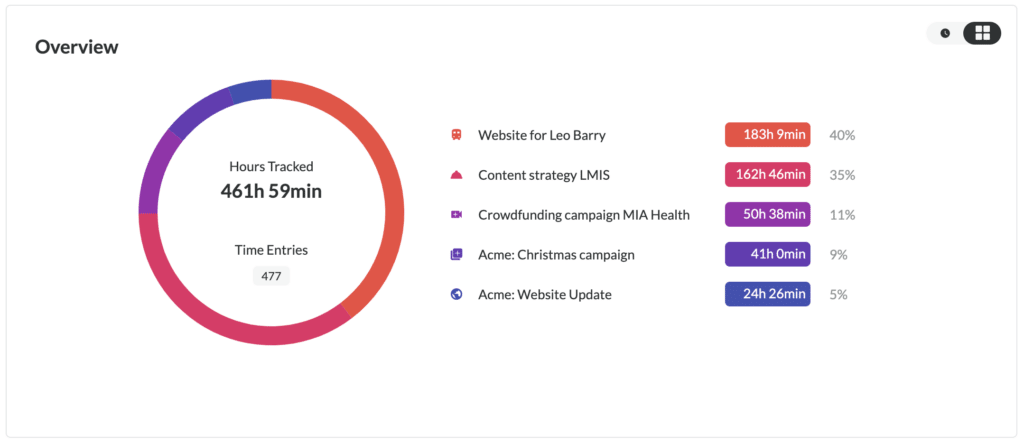
A quick calculation like the one below shows us that 2 projects are profitable, one is neutral, and two are unprofitable. Both are for the same client: Acme.

While this gives us a good high-level overview, we’re not done. The next step is to understand the details of all projects because as we will see later, it will lead to some surprising insights.
It might come naturally to only look more closely at the break-even and unprofitable projects, but we should look at profitable projects too because there is something to learn for the other projects and we might just have been lucky.
Let’s take a look at the activities of the Crowdfunding campaign MIA health which based on our calculations is very profitable.
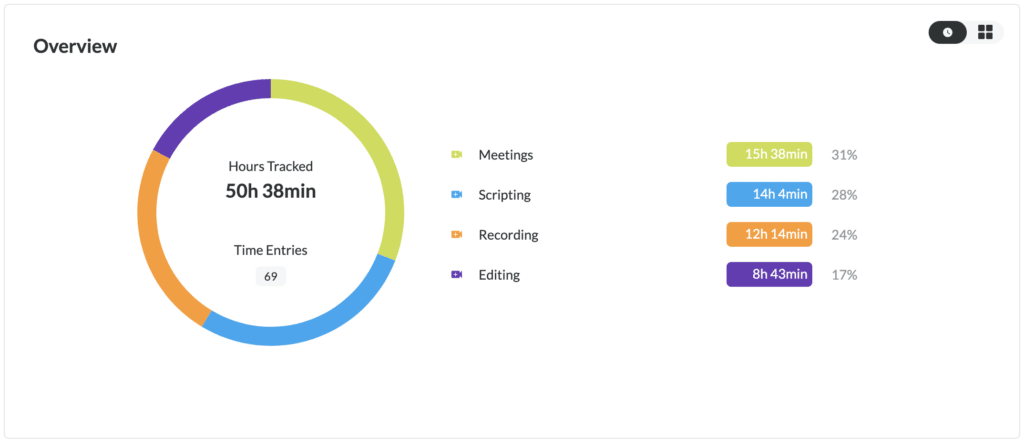
If we compare the totals of this project with our initial estimations we see that we just got lucky, as Editing and Recording was much quicker than we thought. On the other hand, we spent more on Scripting and Meetings than anticipated. Let’s note these insights down for a moment and see in the next chapter what to do about it.
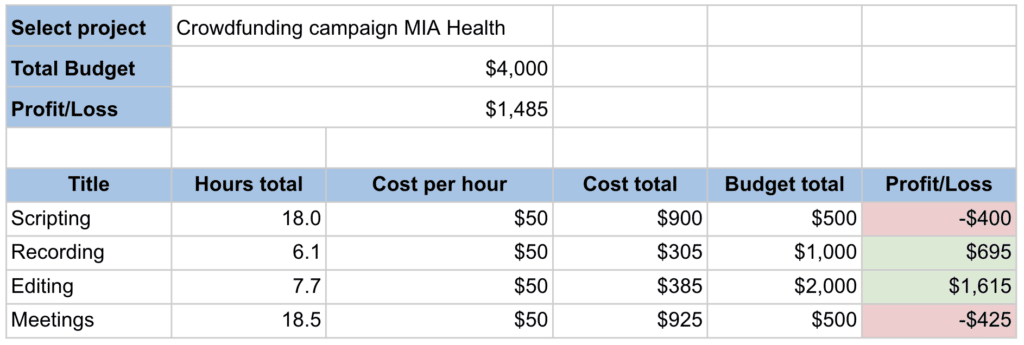
Let’s look as well at the unprofitable project Acme: Website Update below. At first glance, it seems our planning was much worse than the previous project. But if we look more closely we can see that the planned activities were on target. We just didn’t have a budget for Meetings and Media design. What happened?
First, we underestimated meetings again, or more precisely, we didn’t estimate them at all. Second, we thought it would be faster to do the creatives on our own just to get the website out in time and make the client happy. At our cost.

Let’s summarise our insights:
- Both projects for Acme were unprofitable
- We underestimated Meetings twice
- We underestimated Scripting and Media design
- We overestimated Recording and Editing
Take action to increase profitability
Now that we know what is profitable and what is not, what to do about it? Of all the things you can do, below are the 3 most common options.
1. Scale your profitable activities and projects
- Can you do more for the profitable clients?
- Can you find similar clients looking for the activities you offer?
- Can you do some projects or activities even more efficiently?
2. Improve or stop doing unprofitable activities and projects
- Is there a way to do unprofitable activities more efficiently?
- Can you increase the pricing for those activities?
- Can you charge money for last-minute scope changes and unplanned things?
- Can you commit the customer to a new project and factor in some of the loss there?
- As harsh as it sounds, can you stop doing those activities or even fire the customer?
3. Estimate more realistically in the future
- Usually, everything takes longer than planned and the scope usually increases. Most seasoned agencies know that. Therefore they add a buffer of 10-20% for unplanned work, estimation errors, and non-billable work.
- We’re not machines performing 100% all the time. We need those coffee breaks, internal meetings, and get-togethers to keep motivation and the team spirit high. On the other hand, someone needs to pay for that time, hence you need to add another 5%-20% on your hourly rates and retainers for those things. If >20% of your time is for non-billable work, it’s a good time to think about how to get that non-billable stuff done more efficiently.
As you can see there are many options and it’s up to you to find out which one works for you and your business goals. The important thing is just that you do something proactively, otherwise, you’re leaving the success of your agency up to luck.
Résumé
Increasing profitability gives your agency stability and freedom to choose your clients, projects, and ways to do things. The key to increasing your profitability is to have the team provide accurate time-tracking data as early as possible. The easier it is for the team to track time, the more accurate data you’ll get. Try Timeular free for 30 days and for help and questions, please get in touch at [email protected].
You might find our other guides helpful too: